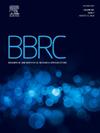Intravitreal indocyanine green is toxic to the retinal cells
IF 2.5
3区 生物学
Q3 BIOCHEMISTRY & MOLECULAR BIOLOGY
Biochemical and biophysical research communications
Pub Date : 2024-10-22
DOI:10.1016/j.bbrc.2024.150872
引用次数: 0
Abstract
Background
Indocyanine green (ICG) is widely used to stain the epiretinal membranes and internal limiting membranes during the pars plana vitrectomy (PPV). This study aims to evaluate the effect of ICG on rat retinas and various retinal cell lines, including ARPE-19 cells, rMC-1 cells, BV2 cells, HRMECs and R28 cells.
Methods
ICG solutions were prepared and diluted with glucose solution (GS) according to the standard clinical protocols. The retinal cell lines, including ARPE-19 cells, rMC-1 cells, BV2 cells, HRMECs and R28 cells, were treated with the following solutions: normal glucose (NG, 5 mM), GS-1 (92.5 mM glucose), GS-2 (185.02 mM glucose), ICG-1 (92.5 mM glucose + 0.43 mM ICG), or ICG-2 (185.02 mM glucose + 0.86 mM ICG) for durations of 15 or 30 min. In vivo, the right eyes of the rats were intravitreally injected with ICG-1 or ICG-2 (2 μL), while the left eyes were intravitreally injected with GS-1 or GS-2, served as the osmotic controls, for 30 min or 60 min. The rats intravitreally injected with an equivalent volume of NG or 1x phosphate-buffered saline (1x PBS) were served as the normal control or vehicle control. The cell viability was measured with the Cell Counting Kit-8 (CCK-8), while the cell death in retinal cryosections was detected with the TUNEL assay.
Results
The viabilities of the different retinal cell lines involved in this study were significantly reduced by both ICG-1 and ICG-2 treatments at both time points, with ICG-2 resulting in lower cell viability compared to the NG group and the osmotic control group. Additionally, GS-2 treatment also exhibited a decrease in retinal cell viabilities in vitro. To further confirm these results, intravitreal injection of ICG or GS induced more apoptotic cell death in rat retinas as evidenced by the TUNEL assay.
Conclusions
The exposure of ICG or its solvent leads to an augmented retinal cell death, which is directly proportional to the concentration and duration of exposure, both in vivo and in vitro. Caution should be exercised during vitrectomy procedures involving ICG administration during clinical practice. It is recommended to advocate for lower concentrations of ICG with reduced exposure time during ocular surgeries.
玻璃体内的吲哚菁绿对视网膜细胞有毒性。
背景:吲哚菁绿(ICG)在玻璃体旁切除术(PPV)中被广泛用于染色视网膜外膜和内缘膜。本研究旨在评估 ICG 对大鼠视网膜和各种视网膜细胞系(包括 ARPE-19 细胞、rMC-1 细胞、BV2 细胞、HRMECs 和 R28 细胞)的影响:按照标准临床方案配制 ICG 溶液并用葡萄糖溶液(GS)稀释。包括 ARPE-19 细胞、rMC-1 细胞、BV2 细胞、HRMECs 和 R28 细胞在内的视网膜细胞系分别用以下溶液处理:正常葡萄糖(NG,5 mM)、GS-1(92.5 mM 葡萄糖)、GS-2(185.02 mM 葡萄糖)、ICG-1(92.5 mM 葡萄糖 + 0.43 mM ICG)或 ICG-2(185.02 mM 葡萄糖 + 0.86 mM ICG),处理时间为 15 或 30 分钟。在体内,大鼠右眼静脉注射 ICG-1 或 ICG-2(2 μL),左眼静脉注射 GS-1 或 GS-2(作为渗透对照),时间为 30 分钟或 60 分钟。大鼠静脉注射等体积的 NG 或 1x 磷酸盐缓冲盐水(1x PBS)作为正常对照或载体对照。细胞活力用细胞计数试剂盒-8(CCK-8)测定,视网膜冰冻切片中的细胞死亡用 TUNEL 法检测:结果:ICG-1 和 ICG-2 处理在两个时间点上都显著降低了本研究中不同视网膜细胞系的存活率,其中 ICG-2 导致的细胞存活率低于 NG 组和渗透对照组。此外,GS-2 处理也会降低体外视网膜细胞的活力。为了进一步证实这些结果,在大鼠视网膜中静脉注射 ICG 或 GS 会诱导更多的细胞凋亡,TUNEL 试验证明了这一点:结论:无论是在体内还是在体外,接触 ICG 或其溶剂都会导致视网膜细胞死亡增加,这与接触的浓度和持续时间成正比。在临床实践中,玻璃体切除术中使用 ICG 时应谨慎。建议在眼科手术中使用较低浓度的 ICG 并缩短接触时间。
本文章由计算机程序翻译,如有差异,请以英文原文为准。
求助全文
约1分钟内获得全文
求助全文
来源期刊
CiteScore
6.10
自引率
0.00%
发文量
1400
审稿时长
14 days
期刊介绍:
Biochemical and Biophysical Research Communications is the premier international journal devoted to the very rapid dissemination of timely and significant experimental results in diverse fields of biological research. The development of the "Breakthroughs and Views" section brings the minireview format to the journal, and issues often contain collections of special interest manuscripts. BBRC is published weekly (52 issues/year).Research Areas now include: Biochemistry; biophysics; cell biology; developmental biology; immunology
; molecular biology; neurobiology; plant biology and proteomics

 求助内容:
求助内容: 应助结果提醒方式:
应助结果提醒方式:


